
16 May-7 June 2018.
All the stories that couldn’t find a home in any of the other posts about China:
The Great Wall: I was in China for four weeks so of course I went to the Great wall. Only I didn’t really see it. As you can see from the picture above it was completely blanketed in fog. It was a very mysterious experience.
I opted to take the cable car up.
Even taking the cable car it’s a long hike if you want to see anything of the wall once you’re up on it, with many stairs to be negotiated at each watchtower.
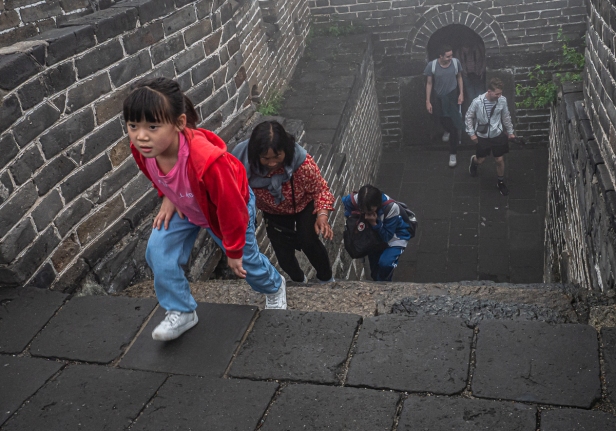
Although parts of the wall date back as far as the 7th century BCE, the most well-known parts date from the Ming Dynasty (1368–1644). There are actually several walls, built by different dynasties, but together the walls mostly follow an arc roughly along the edge of the Mongolian steppe. In total it’s about 21,000 kilometres (13,000 miles) long. That’s a lot of construction. Despite the myth, it actually can’t be seen from space, but is still undoubtedly one of the most impressive architectural accomplishments of all time.
Watchtowers punctuate the wall and were also used for storage and living quarters for the soldiers.


Walking from watchtower to watchtower I had a feeling of aloneness, of emptiness. Perhaps it was the fog. Even the few fellow tourists were swallowed by it.
What a tough isolated life it must have been for the soldiers who lived there in their cold rough barracks. And yet on a clear sunny day the views must be breathtaking.
I began at watchtower number 15, walked up to number 17, then all the way in the other direction to number four then back up to number 6 for the chairlift down. I covered over twelve kilometres that day. It was a good hike in a shrouded veil punctuated by a bunch of school kids on an excursion, their energy and enthusiasm bringing a smile to my face.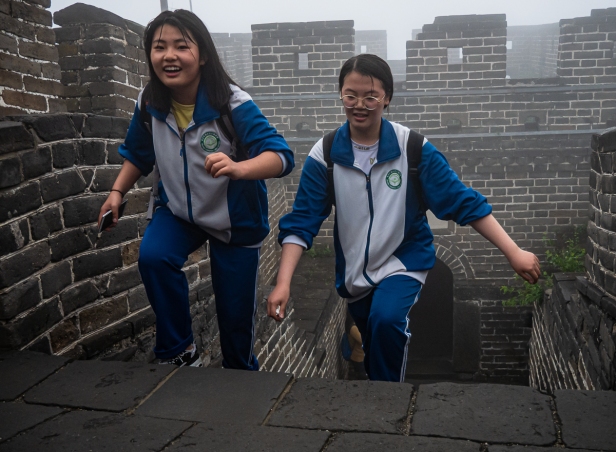

Leaning out through one of the crenellations I could get a sense of the outside of the wall, and almost a sense of the endless extent of it that I was denied by the weather. It’s a huge structure, which can’t really be appreciated until you are actually on it.
Was I disappointed about the weather? Of course, but it was still a remarkable experience.
***********************
Communication: Okay I’ll start by saying that me trying to write in Chinese would be completely hopeless. I can’t even imagine how difficult it would be to learn written Chinese. Even so, with humble respect, it was often amusing to see their attempts at written English.
A storefront with a huge sign: Big Gynaecological Big Brand. Huh?
Breast Supply on the Yangtze River cruise boat: coffee, tea, yogurt, acorns in mousetraps (?), cereal, fruit juice.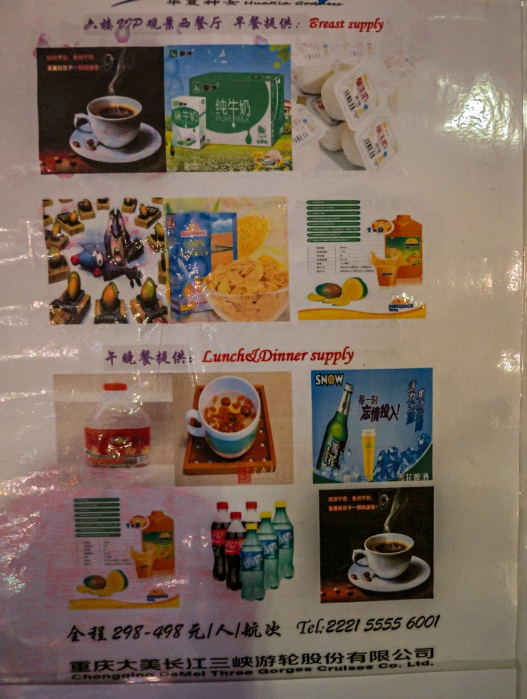
A sign at the Li River. Don’t have fun!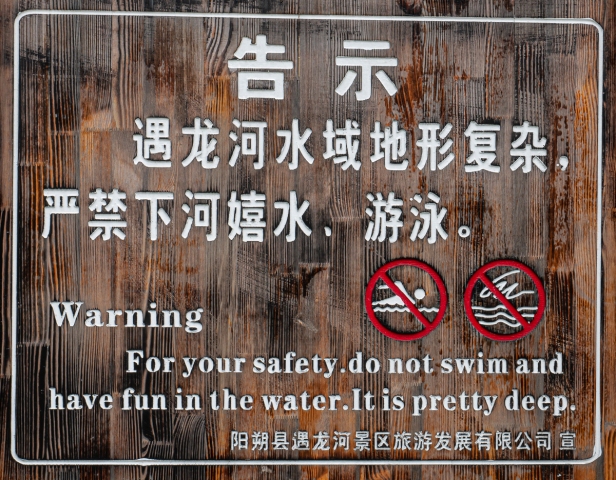
Some not so hot tips in the forest at Emei Shan: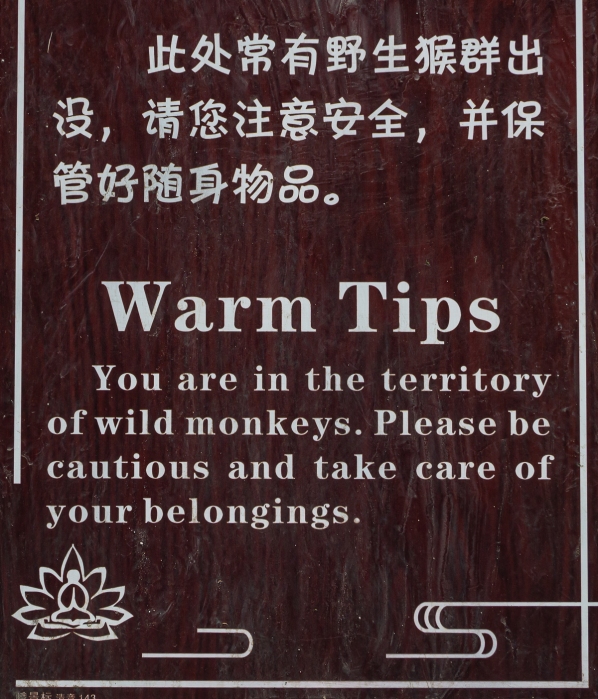
Blasting Juice! A clear confusion between the letters c and e:
My almost favourite:
One of those bars across the top of taxis with scrolling letters formed by lights. So we’re stuck in slow traffic and I get to watch this taxi for quite a long time. The Chinese characters scroll by over and over, no doubt advertising something. Every now and then a little English appears. The first thing in English is Up U!
And definitely my favourite:
We’re at a spa with many pools of water of varying temperatures cascading down a hill. From one level to the next there is a slide but for some reason they’ve closed it off. The sign? Please feel free to enjoy the inconvenience.
Speaking of language, when I go to a new country I always learn how to say hello, goodbye, please, thank you, and I’m sorry. In China (also in Japan where it is dōitashimashite) I learned to say “you’re welcome” (or the equivalent thereof). Thank you in Chinese is shia shia. I found myself being absurdly pleased when they would respond boo ker chee and I knew what they were saying. Communication win!
On one occasion I walked into a public washroom, which was empty except for a woman mopping the floor. I walked down the line of stalls to see if the symbol on any of the doors indicated a western toilet. Nope. So I walked out again knowing that there would be one in the washroom for the disabled nearby. As I was walking out the woman started shouting at me. Shouting! So I shout back “I have no idea what you’re saying but I can shout as loud as you can!” Communication fail.
*****************************
Sugar People: In this traditional Chinese folk art the artisan uses hot liquid sugar to create three-dimensional figures. A pre-requisite is a willingness to develop asbestos fingers. I know what that’s like from years of cooking on wood stoves in wilderness camps in the far north of Canada. The semi-liquid viscous sugar is moulded, and then blown in a similar way to glass blowing. The art form has been practiced in public spaces in China for hundreds of years and can still be seen today in most busy places. I’d never seen it before, but came across an expert in a little hole-in-the-wall in one of the hutongs in Beijing.
The figures are created as decorative pieces rather than to be eaten since they are formed by the vendor blowing through a hollow tube of slowly hardening liquid sugar. Dragons, pigs, roosters, fish, horses. I watched as he produced a piece. As always I’m amazed by the creativity of us humans! Who ever would have thought this up? And how? Oh I know, I’ll just take a lump of hot viscous sugar, not let myself notice that my fingers are burning, put a little dent in it, start blowing and see what happens. Really?
******************************
Han Yang Ling Mausoleum and museum: I’m in a large dark room staring down through the glass panel at my feet into a long deep pit dug into the earth. The lighting is minimal, presumably to protect the artefacts, but it is enough to see the clay figurines at the bottom of the pit. Hundreds of them, in pit after pit.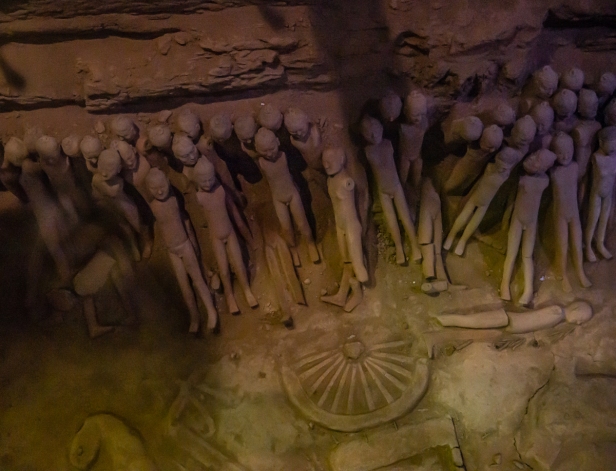
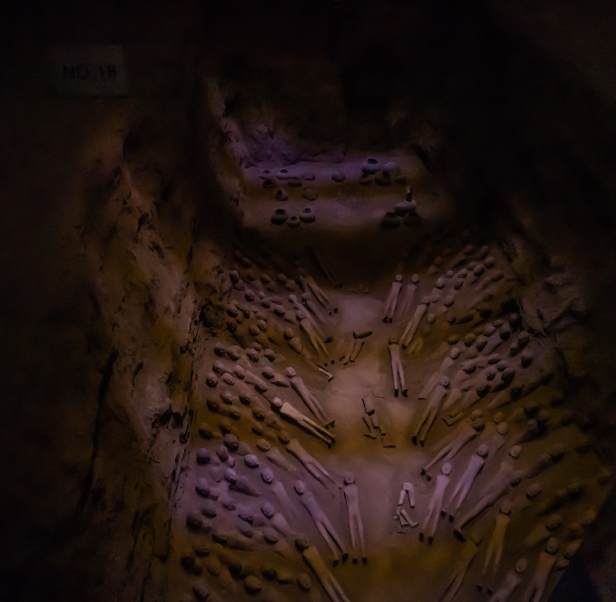

It is the mausoleum of the Han Emperor Jing, known as Liu Qi (188-141 BCE). There are eighty-six burial pits, a criminals’ cemetery, a human sacrifice graveyard, two large burial mounds accommodating the bodies of the emperor and his wife,
and 50,000 figurines. Fifty thousand! These miniature figurines represent the daily life of the court and include eunuchs, servants, tools, domesticated animals, and carriages.

There are thousands of animals – horses, dogs, sheep, goats, pigs, ducks, chickens. Some are in the pits, some are displayed in huge glass-walled cases.



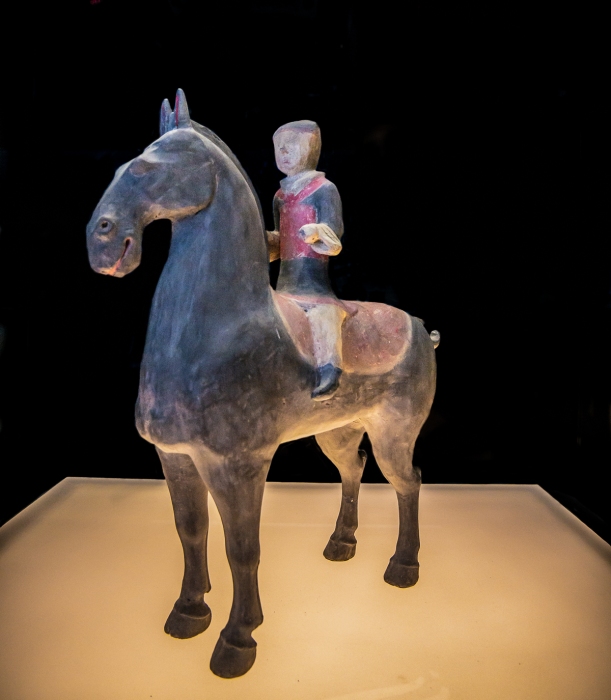
The anatomically correct human figures originally had wooden arms and were dressed in bright silk robes, as can be seen in the life-size replicas.
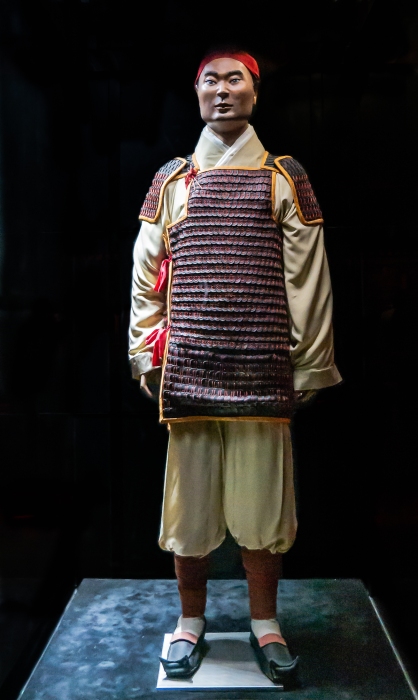
The Yang Ling mausoleum doesn’t have the wow factor of the world-renowned Terracotta Warriors, which are life-size, but the attention to detail in the creation and number of the figurines, and the sheer scale of the place, which covers nearly 5000 acres, are quite mind boggling.
***************************
Chinese people are loud. There’s nothing reserved about them. It was such a shock coming directly from Japan where the opposite is true. Many Japanese customs are actually Chinese in origin, and yet the two cultures have developed in such vastly different ways. They’re so different! How did that happen? In Japan it is all order, politeness, and striving for perfection, with a great consciousness of personal space. The Chinese have a much less restrained notion of personal space, and in China it’s all loud and big – big construction, big vision, big projects, and a big just-get-it-done mentality. As a result there is much that they have got done! From ancient times (the biggest archaeological site in the world is the Terracotta Army) to modern (the bridge from Hong Kong to Macau is the longest over-sea bridge in the world) the Chinese have created some of the world’s greatest wonders. They will tackle anything, and they are raucously unrestrained. Japanese people are quiet and polite. They never make loud noises in public and they are embarrassed if they do. Chinese people are the opposite. It hardly seems fair to make a comparison between the two cultures but since I went directly from one to the other it was really really hard not to notice the difference. It’s the difference between I’ll take care not to get in your way and get out of my way. Both countries no doubt have their own version of fierceness; it’s just that in Japan it’s a kind of secret. In China it’s pretty much in your face.
In both countries I was appalled by the use, overuse, flagrant-uncaring-unrestrained-unconscious use of throwaway plastic. Clearly they have not yet received the message of the worldwide problem with plastic pollution. In Japan you will find individual bananas wrapped in plastic. In China it can probably best be summed up by this: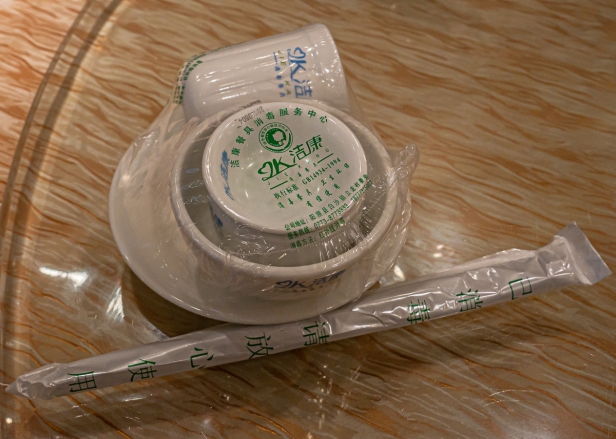
Every stack of dishes at every setting at every table in this large restaurant was shrink-wrapped in plastic, as well as plastic wrappers on the chopsticks.
China:
* has the world’s longest bridge spanning 165 kilometres! It’s the Danyang–Kunshan Grand Bridge and is part of the Beijing-Shanghai High-Speed Railway.
* has more high-speed rail tracks than most of the rest of the world put together.
* has the biggest worldwide farm output.
* is the world’s largest economy, and it is larger than all of Europe combined.
* is home to the world’s largest data centre – China Telecom’s $3billion, 10.7 million square foot hub in Inner Mongolia.
* has the world’s highest bridge standing 1,854 feet over the Beipan River.
* has the largest imperial palace, the Forbidden City, which is more than three times larger than the Louvre in Paris.
* has, of course, the world’s biggest population at 1.4 billion.
Size matters in China. In the third century BCE an entire royal court was created as a mausoleum for the first emperor that included 8000 life-size clay soldiers, and then in 150 BCE 50,000 figurines were made for the mausoleum of Emperor Jing. Clearly the whole notion of doing things on a grandiose scale goes way back. And even today, especially today, China looms large on any list of fastest, biggest, highest, longest. It was really brought home to me when I visited the mausoleums, and when I went to the two outdoor performances – War of the Three Kingdoms, and Impressions Sanjie Liu. The scale and magnitude of both was way beyond anything I’d seen before. And yet, down on the ground it’s just life: people living their lives, taking care of their kids, gathering in the parks, feeding the pigeons, making it work whatever way they can. Like many countries there are poor people, and wealthy people, and these days a huge middle class who are enjoying a level of wealth and freedom that was unheard of only forty years ago. It’s a huge, fascinating country, and I’m glad I had the chance to see some of it.

For three weeks I travelled the length of China from Beijing to Hong Kong. There was a lot packed into those 21 days of Intrepid Travel’s China Experience tour. It was an amazing trip, and I would recommend Intrepid Travel in a heartbeat. Don and I also travelled with them in Egypt. Take a look at Thirdeyemom’s post about Intrepid. It will tell you all you need to know.
Intrepid Travel sponsored me on this trip, however, as always, all opinions are my own.
Previous posts about China:
Travelling Without Don: new friends in China!
Climbing the Sacred Mountain – China’s Emei Shan
Travelling with a small-group tour in China
Why You Should Visit Yangshuo!
The Forty-Dollar Cup of Tea – and other tales from Beijing
The Quietly Beating Heart of Old Beijing – the living hutongs
The Unbidden Truth of the Forbidden City – Beijing’s palatial heart.
Weird Meals and Fearless Wheels: street food and acrobats in Beijing
The Wheels On The Train Go Round and Round: a long-distance journey through China
You can’t Take it with you but you sure can try! The Terracotta Warriors
Riding High in Xi’an – China’s Ancient Capital
The World Turns On a Cup Of Tea – the Muslim Quarter of Xi’an
Heads Up – China’s Amazing Emei Shan
It’s Not The Mountain We Conquer But Ourselves.* China’s Emei Shan
Some of the Best Experiences of a Three-week Tour of China
Monasteries and Mad Monks – China’s Baoguo Monastery and the Leshan Buddha
Pandering to your love of PANDAS! Now that I have your attention . . . .
Quick Change Artists – the ravishing Sichuan Opera in Chengdu
Yangtze River Cruise: don’t get your hopes up!
War of the Three Kingdoms – like an action movie only live!
The Glorious Landscape of Yangshuo, China – a photo essay
. . . . For All The Tea In China! A tea plantation, a town, and a village in Yangshuo
The Legend of the Song Fairy: Impressions Sanjie Liu
Next post: Hong Kong. I debated whether or not to include Hong Kong as part of the series on China. I know it is under Chinese rule, and with the unrest there these days that is being demonstrated in sharp relief. On the other hand as a Canadian citizen I need a visa to enter China; I don’t need one for Hong Kong. What finally convinced me to separate Hong Kong from the posts on China is that I went through border control and officially exited China before I entered Hong Kong. I don’t know for how long (and it saddens me for the people of Hong Kong that I have to say that) but for now Hong Kong exists under a separate system from the rest of China and so I decided to treat it as such. Besides, it just feels different.
All words and images by Alison Louise Armstrong unless otherwise noted.
© Alison Louise Armstrong and Adventures in Wonderland – a pilgrimage of the heart, 2010-2019.

Your pictures of the great wall in the fog are stunning and eerie at the same time. In a way, it was a good time to visit as there weren’t the crowds you often hear about. We had a Japanese girl live with us for three years. She got very upset if anyone thought she was Chinese. Her first comment was, I am not loud like the Chinese. I have friends from both cultures and find them to be delightful in their own way. Great post.
LikeLiked by 1 person
Thanks so much Darlene. I’m glad I saw the Great Wall even if it was fogged in. It’s a remarkable accomplishment.
It was such an adjustment for me going from Japan to China! What a difference. Not that one is necessarily better than the other at all, just a bit of culture shock, and I certainly understand why a Japanese girl would not want to be taken for Chinese lol
Alison
LikeLiked by 1 person
I like the multiple topics here, all of them quite fascinating!
LikeLiked by 1 person
Thanks so much Kate. Glad you enjoyed it.
Alison
LikeLike
Great round up of your China posts, thank you so much! beautiful pics as always 🙂
LikeLike
Thank you so much Danila. China was a trip! We sure packed a lot into those 3 weeks.
Alison
LikeLike
Intrepid travel sounds awesome and a few years from now we plan to visit just a couple places and we will start by checking out their tours .
I enjoyed this post and it flowed so weLl – the wall photos reminded me so much of “game of thrones” wall and I bet they were inspired by China’s Great Wall ((and did not know it was a myth you could see it from space)
Also loved the school children – my my my how alike we are globally with clothes – adidas and Star wats and slogans on t-shirts!
—
And enjoyed the contrast of Japan and China in the culture norms of quiet and hush vs Loud and in your face!
I am logging off but hope to come back and read the link about the 40$ cuppa !🍮❤️
LikeLiked by 1 person
Thank you so much for your kind comment. I’m glad you enjoyed the post.
Apparently the Great Wall can only be seen from space (ie the level of satellites) with quite a bit of magnification, which probably means other features would also be able to be seen the same way.
Intrepid is definitely worth checking out.They’re a very caring and responsible company.
Hope you enjoy the $40 cuppa!
Alison
LikeLiked by 1 person
Thanks Alison – and send my best to Don!
LikeLiked by 1 person
Fascinating. I love the wall photos in the mist.
LikeLiked by 1 person
Thanks so much Cindy
Alison xo
LikeLike
I think I like this post the best of all your China posts, Alison. The tidbits of life — a little of this, a little of that. The video of the sugar artist had me totally mesmerized. Truly amazing, what people come up with!
As for the need of the Chinese to create things of humongous size and proportions: I can’t relate to that, and so I also can’t really admire it. But I can still marvel at it, the sheer will and effort it must have taken.
And now? You seem to have settled down nicely in Vancouver. Not so much traveling any more. Us neither! But we did spend six weeks in Portugal this past Sept and Oct, and we really enjoyed that. Might go back next year.
Any travel plans on your end?
Hope you and Don are well and in good health and spirits.
LikeLiked by 1 person
Thanks so much Tanya. I was blown away by the sugar artist, and yes it’s so amazing what we create!
China does big so well. I admire the vision! No limits it seems.
We’ve been settled in van now for a couple of years. In February/March this year we went to Paris, Rishikesh (for Mooji), and Kyoto, which I’ll post about after a couple of posts on Hong Kong.
Coming up – two weeks with family in Montreal over Christmas, then in February/March we’re off again – Rishikesh for Mooji again then a couple of weeks in Malaysia.
Portugal is on our list!
We’re both well and content. Hope you two are too.
Alison
LikeLike
I’m very much looking forward to your posts about Rishikesh! As you know, I have a soft spot in my heart for it, but only for the east side of the river where there’s hardly any traffic. If only it weren’t such a long journey to get there ……..
I also don’t know if I’d do well any more with the rajasic energy of the country. Portugal has a calm energy about it, which is one reason why we like it so much.
Anyway …… waiting for your Rishikesh posts! 🙂
LikeLiked by 1 person
I still love India as much as ever. It stole my heart. Along with Japan. And you couldn’t get two more opposite places!
LikeLike
What a fantastic and thorough series about China. Takes me back!!! It is amazing how much you experienced in the space of a mere three weeks. No matter how superficial a tour as a tourist actually is, it is still possible to discern the character of a country. You are right, Japan and China may be neighbours and share a similar past, but their cultures today are a world apart… I had a similar revelation arriving in Malaysia last autumn after travelling through other South East Asian countries and Nepal: I now look upon Malaysia as a little bit of Britain where the weather is so much more agreeable… I loved the order and peace, and being able to cross the roads without fearing that I would be mowed down by uncaring motorists…
Lieve
LikeLiked by 1 person
Thanks so much Lieve. We really covered a LOT of ground in those 3 weeks, and had some amazing experiences. China was definitely culture shock after Japan. It pretty much took me the entire 3 weeks to get used to it.
So nice to read what you think of Malaysia as we’ve just begun to plan a trip there for next March after a month in Rishikesh.
Alison
LikeLiked by 1 person
I have major respect for them learning English, but those signs are hilarious. I think my favorite I saw while in China said, “Love grass and love life.” It was trying to tell people not to walk on the grass. In a bathroom, a sign said: “Take a step closer for a more civilized urinating.”
LikeLiked by 1 person
Oh these are hilarious, especially the second one. Some of the stuff I read in brochures really felt like Google translate – ie no idea of context or colloquialisms.
But yes, I too have major respect for them learning English.
Alison
LikeLike
First of all, congrats on writing all those posts on China, and I love how you’ve found a home here for the other stories that didn’t quite fit. I may have to do the same with my Sri Lanka series.
I know it’s not nice to make fun of poor translations, but I get such a kick out of those signs.
Shame about the fog at the Great Wall but your photos are still impressive and the “moodiness” of the scene is very cool.
Alison, I’ve really enjoyed your China series!
LikeLiked by 1 person
Thanks so much Caroline. I guess I got a bit carried away with the China posts, but there was so much to share, so many amazing places and experiences. I’m glad you enjoyed the series.
I know I shouldn’t make fun of the translations, but they’re just so funny. I’m sure it would be just as amusing for them going in the other direction. I have mad respect for anyone who learns Chinese or Japanese – truly in awe.
Alison
LikeLiked by 1 person
I loved all these snippets. Great idea, because things that don’t ‘fit in’ to other posts get kinda lost. And they are all so wonderful. I thought the wall in the fog was so atmospheric – what must it have been like to have been stuck there for weeks/months on end. And I loved the tomb stuff – never heard of it, and it’s just as fascinating as the warriors, yet one is so well known and the other not. And communication bloopers are always good for a laugh and so intriguing.
LikeLiked by 1 person
Thanks so much Tracey. I did enjoy putting this post together. I knew I wanted to share all these places/experiences and just saved them up for one final post.
The wall in the fog was a good experience. I was not that disappointed, perhaps because funnily enough seeing the wall had not been something a bucket list so I didn’t really have any hopes about it. I’m glad the photos turned out.
I’d never heard of the Yang Ling tomb either. It was one of those excursions that was both a bit boring and amazingly fascinating at the same time.
Alison
LikeLike
China looks and sounds like an incredible place to visit, so different to anywhere else in the world. The mausoleum looks fascinating, absolutely spectacular. Shame about the fog on your wall visit but at least you went and had the experience. We would love to go but it’s just too expensive for us.
LikeLiked by 1 person
Oh for sure China is an incredible place to visit. I didn’t mind the fog on the wall that much, though I do think I’d like to see it on a clear day one day. I hope you’ve enjoyed this little look into China through my eyes.
Alison
LikeLiked by 1 person
So many marvels here, Alison. I don’t think I’ve ever seen pics of the Great Wall befogged. Truly haunting. And then the extraordingary mass of figurines in the mausoleum, and all so finely wrought. I am truly amazed.
LikeLiked by 1 person
Thanks Tish. I had debated a bit about whether to include all these snippets then decided they were too good to skip over. Both the Great Wall in the fog and the Yang Ling Mausoleum were worth seeing, each fascinating in their own way. I think I missed out on the wow factor at the wall, but instead experienced something really quite unique I think.
Alison
LikeLiked by 1 person
I wonder which stretch of the wall you visited!! The photos are wonderful!!!
LikeLiked by 1 person
Thanks so much Matt. Not definite about this, but I’m pretty sure we were at Mutianyu.
Alison
LikeLiked by 1 person
Weird and wonderful, and possibly a threat to civilisation if they don’t get their plastics act together? The photos of the wall are captivating… even the bits you can’t ‘see’. Reminds me of Hadrian’s Wall, but the scale is immense and I would love to see it for myself. The figures, too, and the sugar-blower! Fascinating stuff, Alison. 🙂 🙂
LikeLiked by 1 person
Thanks so much Jo. Oh the whole plastics thing just breaks my heart – people are so unconscious about it. 😦 If a small city in India (Rishikesh) can go single-use-plastic-bags free, surely anywhere can.
Weird and wonderful is a good way to sum up China. Amazing place, even the wall in a fog.
Alison
LikeLiked by 1 person
Love the final China round-up, Alison! The wall looks very cool in that ethereal fog, and I loved your collection of the humorous and/or inexplicable translation errors. My grad school education was in linguistics, so for me, it’s extra fun in various parts of the world to try to figure out (or imagine, in some cases) where the breakdowns occurred. Far from making fun, like you, I readily acknowledge that I could not even make a similar effort in many of the languages I’ve encountered!
LikeLiked by 1 person
Thanks so much Lexie. The wall was a pretty cool experience – especially trying to capture the feel of it anyway even tho it was fogged in.
The language thing always amuses me, but yeah, in the reverse direction I suspect it would be dire.
Alison
LikeLiked by 1 person
Wow that is a veritable feast of experiences in one post, Alison. I quite love the feel of your foggy shots of the Great Wall. They conjure up a proper atmosphere, if I might put it so. It is a pleasure to read your posts as always. 🙂
LikeLiked by 1 person
Thank you so much DDG. I’m glad you enjoyed the post. China was definitely a feast for the senses – so many amazing experiences.
Alison
LikeLike
You are welcome, Alison. Till I get to experience all of this in person! Cheers. 🙂
LikeLiked by 1 person
It is unfortunate that the weather was far from ideal when you went to the Great Wall. Nevertheless, from your photos the walls’ massive size is still palpable. Speaking of the English signs, I remember reading a funny one in Guangzhou’s metro. I can’t remember what it was, but I had to ask James (who can read Chinese characters) what was lost in translation. It’s interesting that you mentioned about the stark contrast between Japanese and Chinese cultures because at one point I was also wondering about that since, as you said, a lot of aspects in Japanese culture actually originate from China. I’m looking forward to reading your post on Hong Kong — I’ll be there for Christmas, and due to the current circumstances I’m both nervous and curious of what I will see in the city this time around.
LikeLiked by 1 person
For some reason the Great Wall had never been on my bucket list. It never loomed large in my imagination as some place I just had to see so I was disappointed of course, but not that much. Not like I was at Pamukkale in Turkey where I’d seen all the beautiful turquoise pools of water and when I was there, there was no water in the natural pools at all. It was so disappointing to not see it the way I’d seen it in all the iconic photos. Maybe one day I’ll get back to China and see the wall in all its glory.
I was blown away by the difference in the general characters of the two countries, being really highlighted of course by going directly from one to the other. Complete opposites.
Hong Kong was lovely. I really enjoyed it, at least in part because there is English on all the signage, and many people speak English so I didn’t have to deal with communication issues. It really does make travel a bit more relaxing. Apart from poking around Kowloon and HK Island a little, my main excursions there were a day trip to Lamma Island and Cheung Chau, and hiking the Dragon’s Back – both really great days. Hopefully things will be better there for you guys at Christmas. Stay safe!
Alison
LikeLiked by 1 person
I remember that post on Pamukkale. I guess it is inevitable that at some point we will be disappointed by places that do not meet our expectations, and it has happened to me as well several times in the past.
I love the Dragon’s Back for its proximity to the city, while my fondest memory of Lamma Island is the seafood that I had there. I only went to Cheung Chau last year, and I actually quite liked it despite its popularity compared to other islands. I don’t expect to explore much this time given the unpredictability of the city’s situation. But I do hope for a quiet Christmas week. Thanks Alison!
LikeLiked by 1 person
Alison, I really enjoyed this grab-bag of moments and observations from your time in China.
It never did occur to me that you hadn’t covered the Great Wall in your earlier posts on Beijing, and now I know why! I’ve heard good things about the Mutianyu section you visited, though my favorite part of the Great Wall is slightly farther out of town at a place called Jinshanling (literally “Gold Mountain Ridge”). What I loved most about it (apart from the lack of crowds) was its partially ruined state. There seems to be a tendency in China to over-restore historic places, especially if they’ve been declared a UNESCO World Heritage Site, and that hadn’t (yet) reached Jinshanling when I went in 2012.
As for the funny sign on the Yangtze Cruise ship that said “breast supply”, the entire line before it actually reads: “Sixth floor VIP observation [deck and] Western restaurant, breakfast provisions.” But I couldn’t figure out that random illustration showing the mousetraps and acorns!
Now that you’ve been to both Japan and China, I wonder what you might make of Taiwan. It was colonized by Japan for 50 years so there’s a clear Japanese influence in the way people do things – not just in terms of overall politeness but also how souvenirs are packaged and meals presented. At the same time the raucous Chinese undercurrent is there (they have a crazy fireworks festival to prove it) but people do talk at a normal volume in public. And then there’s the “aboriginal” heritage of Taiwan that China doesn’t have at all. Culturally and linguistically the island’s indigenous groups are much closer to the Philippines and Indonesia/Malaysia than China itself.
I’m so looking forward to your next series on Hong Kong and whether or not you still recognized it 30+ years (or more?) after your very first trip there. 🙂
LikeLiked by 1 person
Thanks so much James. I would have loved to have seen a more out-of-the-way part of the wall (which I’ve come across before on blogs and videos) but clearly this was not really the trip to see the wall at all, let alone a more distant place.
We were offered (for a fee) to have our meals in the VIP restaurant, but we all opted to stay with the crowd. We didn’t see the need to pay more to be isolated from the rest of the passengers, and it turned out to be the right choice. The food was plentiful and good. It’s funny that the Chinese says it’s the breakfast provisions for the VIP restaurant. Maybe it’s the same offering for both restaurants. The acorns in mousetraps are a puzzle aren’t they?
Taiwan has been on our list for quite a while, and we have friends living in Taipei. You make it sound very appealing. Early next year we’re off to Rishikesh for a month, and then to Malaysia for a couple of weeks. Maybe Taiwan the year after.
It’s been 40 years since I spent 6 weeks in Hong Kong – enormous difference as you’d expect. More cosmopolitan/less provincial, more modern/less local character.
Alison
LikeLiked by 1 person
Glad you enjoyed learning so much in China.
LikeLiked by 1 person
Thanks Jean. China was a trip that’s for sure!
Alison
LikeLike
The Great Wall in the fog is absolutely beautiful – to me, not at all disappointing, but as haunting as it is ancient. “Please feel free to enjoy the inconvenience” – now that’s a very useful slogan, isn’t it? Good spot, glad you recorded that one. 🙂 I’ve never heard of sugar blowing – very cool – no, not. But it’s interesting. Han Yang Ling Mausoleum seems to have quite a lot of wow factor, even if it’s not life-size. Amazing. Your observations about the culture, especially having just visited Japan, are very interesting. I’ve always understood differences like those you point out to be based on the very limited amount of land the Japanese live on. Lots of people on a small island necessitates ways to manage the potential problems, for better and worse. Maybe that’s too facile a view but there’s probably truth to it. I’m looking forward to your post about Hong Kong. I’ve always been curious about it. It’s troubling to see what’s going on this year there but the world seems to be in a rough patch overall. Meanwhile, we will keep living our lives, as you describe the Chinese doing, trying to keep from making problems worse, maybe making things a little better.
LikeLiked by 1 person
This post was a grab bag of things I hadn’t written about but thought worth sharing. It’s an amazing place, and we owe so much to the Chinese culture, mostly without even realizing it. Silk. Tea. Sugar People. Fireworks. Terracotta Army. It’s an extraordinary place.
I will remember the “please feel free . . .” slogan. I may even use it from time to time as appropriate 🙂
I don’t know about the size of Japan affecting the culture though it may be part of it. When I was there I was told the following fascinating story: Japan was closed to the world for hundreds of years. The merchants were the lowest of the low and it was impolite for them to even look at any higher-ups. They were always bowing, head down, doing everything as perfectly as possible to avoid punishment. When Japan opened to the world merchants became important, and with time they became pretty much the most important, and many of course became wealthy. But the self-effacement, and bowing, and striving for perfection was ingrained and became part of the culture.
I too am troubled by what’s happening in Hong Kong. I’ve been twice, the first time for 6 weeks 40 years ago, and then for 3 days at the end of this trip. Loved it both times. It really is different from mainland China.
Alison
LikeLiked by 1 person
I never heard that about the merchants in Japan – of course, I knew Japan had been closed for a long time and that had many effects on the country, but what happened to the merchants as a result of the opening of Japan – interesting! Thanks!
LikeLiked by 1 person
Another packed post, Alison. China is indeed a fascinating place and I have enjoyed your posts on it. My favorite photo this time was the side of the wall with trees and fog— I felt it was very far east in its feeling. –Curt
LikeLiked by 1 person
Thanks so much Curt. I’m glad you’ve enjoyed my stories from China. It was a really packed trip.
I also like the photo you mentioned. It gives a hint of how high the wall is, and how huge.
Alison
LikeLike
I was also amazed by all of the one-upmanship.
LikeLiked by 1 person
I can claim to have foggy memories of places, but nothing like what you have at the great wall. For some reason, your comments about the Chinese thinking biggest for everything and maybe being a little loud and rowdy reminded me of the stereotypical Texan.
LikeLiked by 1 person
I can’t remember when I was in a fog like the one at the Great Wall. We were pretty blanketed in. I chuckled about you likening the Chinese to Texans. You’ve probably got a point.
Alison
LikeLiked by 1 person
The Great Wall is still pretty great in the fog! Would love to travel here. Roared at ‘Please feel free to enjoy the inconvenience’ The spun sugar is very cool. I was not familiar with the Yang Ling mausoleum and find it an interesting alternative to The Terracotta Warriors.
LikeLiked by 1 person
I just felt I had to share these little snippets of my time in China. Each not enough for a full post, but worth mentioning anyway.
We also laughed at the “please feel free . . .” Communication can be so fun!
Yang Ling was one of those places where I was both bored and fascinated at the same time. Perhaps it was just my mood that day. The scale of Yang Ling is mind boggling, but the Terracotta Warriors completely blew me away.
Alison
LikeLiked by 1 person
What a lovely photo blog on China. I’m so happy that you have covered the tiniest details of everyday life in China! Loved reading it!💕
LikeLiked by 1 person
Really enjoyed reading it. China is in my bucket list!
LikeLiked by 1 person
Thank you so much Puloma. I’m glad you enjoyed it. China is a really amazing country, and definitely worth visiting. I hope you get there one day!
Alison
LikeLiked by 1 person
Hi Allison, thank you so much, yes I hope to visit someday. Keep sharing your wonderful experience!
LikeLiked by 1 person